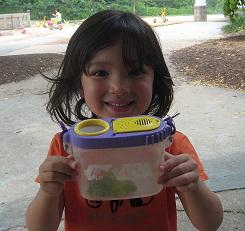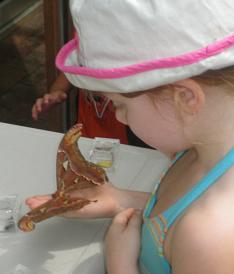
The Center for Young Children is a lab school located on the campus of the University of Maryland. The Red Room is a mixed age group of 18 children from 3 to 5 years of age. Summer camp at the CYC is only six weeks long, so the traditional method of choosing a project by observing the groups interests for several weeks was not possible. Because many of the children in the summer camp attended CYC during the school year, the teachers assessed what they previously knew of these children and decided upon a bug project in advance. Because of the abundance of insects and bugs in the summer, this seemed like the ideal time to do this project.
During one of the teacher's preliminary workshops, designed to introduce new teacher's to the project approach, teachers where required to help each other brainstorm ideas for their topics. Ideas for the Bug Study consisted of places to find them, ways they move, kinds of bugs, what they eat, etc.

The Project Approach is an investigation of a subject in the real world of children. A topic for investigation must be something that the children can readily find in their here and now world and field trips are planned to further their learning on the topic. For instance a Rain Forest would not make a good topic for preschoolers living in the Washington DC suburbs, but a study of the plants grown around their school would be. The topic needs to be something of natural interest to the children involved. The Project Approach has three phases.

Phase I initiates the project by having the children share what they already know about the subject in question and finding out what they want to learn more about. At this point questions are formulated by the children.
Phase II is the investigation where children observe, read, experiment, explore, draw, and ask experts to help them answer their questions.
Phase III is the culmination of the project where the children and teachers decide how to complete the study and document their learning. The event can be a book, a "museum", or a gallery. Sometimes others are invited to come and see what the group has learned.
Through all of these phases of learning,standards for preschool children are addressed. With careful documentation using pictures and notes, children are exposed to personal and social development, language and literacy, mathematical thinking, scientific thinking, social studies, the arts, and physical development.